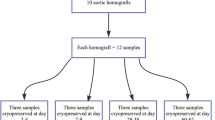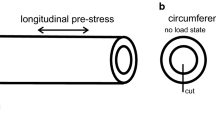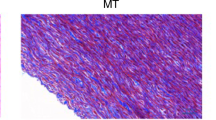Abstract
The use of arterial or venous allografts for vascular reconstruction was first reported in 1951, but long-term results have been disappointing. Rejection and inappropriate methods of preservation are the main reasons for failure. A successful solution to this problem could be achieved by programmed cryopreservation with cryoprotectant. Our study had two aims: to define the biomechanical properties of cryopreserved arterial allografts and to study their histologic appearance. Arteries were removed as part of a protocol for multiorgan harveting for transplantation. Cryopreservation was performed within the first 24 hours after harvesting. Programmed cryopreservation with 15% dimethyl sulfoxide (cryoprotectant) was used. Mechanical testing was done immediately after thawing. Two groups were tested: a control group of fresh aortas and a group of cryopreserved aortas. Axial and circumferential strips were tested. High strain modulus and stress and strain characteristics were calculated for each strip. There was no statistically significant difference between the mechanical properties of fresh and cryopreserved human descending thoracic aortas. Biochemical tests were performed in the preservative solution at 1 and 7 days in both groups. There was no statistically significant difference between the two groups at day 1 or day 7 (p > 0.05). Histologic studies before and after arterial cryopreservation included standard and electron microscopy and showed that arteries had normal structure after cryopreservation. These results confirm that programmed cryopreservation with cryoprotectant does not alter the molecular or geometric configuration of collagen or elastic fibers. Endothelial cells were still present; however, their viability and function were not assessed. The results of our studies have encouraged us to use cryopreserved arterial allografts for clinical application, and to date 27 patients have received cryopreserved arterial allografts. Definitive results including histologic and immunologic findings will be reported in the future when the length of follow-up is adequate.
Similar content being viewed by others
References
Oudot J. La greffe vasculaire dans les thromboses du carre-four aortique. Presse Med 1951;59:234–236.
Gross RE, Bill AH, Pierce EC. Methods for preservation and transplantation of arterial grafts. Observations on arterial grafts in dogs. Report of transplantation of preserved arterial grafts in 9 human cases. Surg Gynecol Obstet 1949;88:689–695.
Dubost C, Allary M, Oeconomos N. Anévrysme de l'aorte abdominale traité par résection et greffe. Arch Mal Coeur 1951;44:848–851.
Veterans Administration Study Group 141. Comparative evaluation of prosthetic, reversed, and in situ vein bypass grafts in distal popliteal and tibial-peroneal vascularization. Arch Surg 1988;123:434–438.
Dennis JW, Littooy FN, Greisler HP, et al. Secondary vascular procedure with polytetrafluoroethylene grafts for lower extremity ischemia in male veteran population. J Vasc Surg 1988;8:137–142.
DeBakey ME. Les greffes d'aortes. In Fontaine R, Dubost C, eds. Les Greffes Vasculaires: Rapport du 56ème Congrès Français de Chirurgie. Paris: Presse Universitaire de France, 1954, pp 264–265.
Rob C. Obliterations of the aortic bifurcation (Leriche's syndrome): Surgical treatment. Minerva Cardioangiol Eur 1957;5:110–116.
Cockett FB. Obliteration du carrefour aortique (syndrome de Leriche). Minerva Cardioangiol Eur 1957;5:143.
Szilagyi DE, Rodriguez FT, Smith RF, et al. Late fate of arterial homografts: Observations 6 to 15 years after implantation. Arch Surg 1970;101:721–733.
Ross DN. Homograft replacement of the aortic valve. Lancet 1962;2:487–494.
Barratt-Boyes BG. Homograft aortic valve replacement in aortic incompetence and stenosis. Thorax 1964;19:131–141.
Paneth M, O'Brien MF. Transplantation of human homograft aortic value. Thorax 1966;21:115–123.
Barratt-Boyes BG. Long-term follow-up of aortic valve grafts. Br Heart J 1971;33:60–71.
Carpentier A, Lemaigre G, Ladislas R, et al. Biological factors affecting long-term results of valvular heterografts. J Thorac Cardiovasc Surg 1969;58:467–483.
Mailligan DJ, Lewis JW, Tilley B, et al. The porcine bioprosthetic valve. Twelve years later. J Thorac Cardiovasc Surg 1963;46:726–743.
Walter P, Schmitz H. La Prothèse Vasculaire Hétérologue. Aulendorf: Edition Cantor, 1976.
Stanisic M, Gloor F. Observations histologiques sur les prothèses vasculaires bovines implantées chez l'homme. In Walter P, Schmitz H, ed. La Prothèse Vasculaire Hétérologue. Aulendorf: Edition Cantor, 1976, pp 57–62.
Angell WW, De Lanerolle P, Shumway NE, et al. Valve replacement: Present status of homograft valves. Prog Cardiovasc Dis 1973;15:589–596.
Watts LK, Duffy P, Field B, et al. Establishment of a viable homograft cardiac bank: A rapid method of determining homograft viability. Ann Thorac Surg 1976;21:230–238.
O'Brien MF. Comparison of fresh antibiotic sterilized and cryopreserved viable homografts: Fifteen-year and ten-year clinical experience [abst]. Presented at the International Symposium on the Aortic Root. San Diego: October 1985.
Ochsner JL, Decamp PT, Leonard GL. Experience with fresh venous allografts as an arterial substitute. Ann Surg 1971;173:933–939.
Tice DA, Zerbino VR. Clinical experience with preserved human allografts for vascular reconstruction. Surgery 1972;72:260–267.
Stephen M, Sheil P, Wong J. Allograft vein arterial bypass. Arch Surg 1978;113:591–593.
Bical O, Bachet J, Laurian C, et al. Aortocoronary bypass with homologous saphenous vein: Long-term results. Ann Thorac Surg 1980;30:550–557.
Gelbfish J, Jacobowitz IJ, Rose DM, et al. Cryopreserved homologous saphenous vein: Early and late patency in coronary artery bypass surgical procedures. Ann Thorac Surg 1986;42:70–73.
Weber TR, Dent TL, Lindenauer SM, et al. Viable vein graft preservation. J Surg Res 1975;18:247–255.
Boren HC, Roon AJ, Moore WS. Maintenance of viable arterial allografts by cryopreservation. Surgery 1978;83:382–391.
O'Brien MF, Stafford G, Gardner M, et al. The viable cryopreserved allograft aortic valve. J Cardiac Surg 1987;2(Suppl):153–167.
Sellke FW, Meng RL, Rossi NP. Cryopreserved saphenous vein homografts for femoro-distal vascular reconstruction. J Cardiovasc Surg 1989;30:838–842.
Vassoille R, Perez J. Bases physiques et thermodynamiques de la cryobiologie. Innov Tech Biol Med 1984;5:177–230.
Lebaud PH, Oddou L, Ersham A, et al. Replacement des vaisseaux: Greffons artériels cryoconservés pour accès au sang. Innov Tech Biol Med 1984;5:109–116.
Brockbank KG, Bank HL. Measurement of postcryopreservation viability. J Cardiac Surg 1987;2(Suppl):145–141.
Axthelm SC, Porter JM, Strickland S, et al. Antigenicity of venous allografts. Ann Surg 1979;189:290–293.
Giordano JM, Lamoy RE, Wright CB, et al. A comparison of autografts and frozen, irradiated homografts in canine femoral venous reconstruction. Surgery 1977;81:100–104.
Schmitz-Rizen T, Megerman J, Colvin RB, et al. Immunosuppressive treatment of aortic allografts. J Vasc Surg 1988;7:82–91.
Balch CM, Karp RB. Blood group compatibility and aortic valve allotransplantation in man. J Thorac Cardiovasc Surg 1975;70:256–259.
Tice DA, Zerbino VR, Isom OW, et al. Coronary artery bypass with freeze-preserved saphenous vein allografts. J Thorac Cardiovasc Surg 1976;71:378–382.
Calhoun AD, Baur G, Portier JM, et al. Fresh and cryopreserved venous allografts in genetically characterized dogs. J Surg Res 1977;22:687–696.
Perloff LJ, Reckard CR, Rowlands DT Jr, et al. The venous homograft: An immunological question. Surgery 1972;72:961–970.
Williams GM, Haar A, Krajewskic, C, et al. Rejection and repair of endothelium in major vessel transplants. Surgery 1975;78:694–706.
Ricotta JJ, Collins GJ, Rich NM, et al. Failure of immuno-suppression to prolong venous allograft survival. Arch Surg 1980;115:99–101.
L'Italien GJ, Maloney RD, Abbott WM. The preservation of the mechanical properties of venous allografts by freezing. J Surg Res 1979;27:239–243.
Vesely I, Gonzalez-Lavin L, Graf D, et al. Mechanical testing of cryopreserved aortic allografts. Comparison with xenografts and fresh tissue. J Thorac Cardiovasc Surg 1990;99:119–123.
Malone JM, Moore WS, Kischer CW, et al. Venous cryopreservation: Endothelial fibrinolytic activity and histology. J Surg Res 1980;29:209–222.
Sachs SM, Ricotta JJ, Scott DE, et al. Endothelial integrity after venous cryopreservation. J Surg Res 1982;32:218–227.
Bank HL, Schmehl MK, Warner R, et al. Transplantation of cryopreserved canine venous allografts. J Surg Res 1991;50:57–64.
Morinaga K, Eguchi H, Miyazaki T, et al. Development and regression of intimal thickening of arterially transplanted autologous vein grafts in dogs. J Vasc Surg 1987;5:719–730.
Ricotta JJ, Schaff HV, Gadaz TR. The effect of aspirin and dipyridamole on the patency of allograft vein. J Surg Res 1979;26:262–269.
Chess L, McDermott RP, Schlossman SF. Immunologic function of isolated leukocyte subpopulations. Quantitative isolation of human T and B cells and response to mitogens. J Immunol 1974;813:1113–1125.
Daar AS, Fuggle SV, Fabre JW, et al. The detailed distribution of HLA-A,B,C antigens in normal human organs. Transplantation 1984;38:287–300.
Author information
Authors and Affiliations
About this article
Cite this article
Gournier, JP., Adham, M., Favre, JP. et al. Cryopreserved arterial homografts: Preliminary study. Annals of Vascular Surgery 7, 503–511 (1993). https://doi.org/10.1007/BF02000144
Issue Date:
DOI: https://doi.org/10.1007/BF02000144




